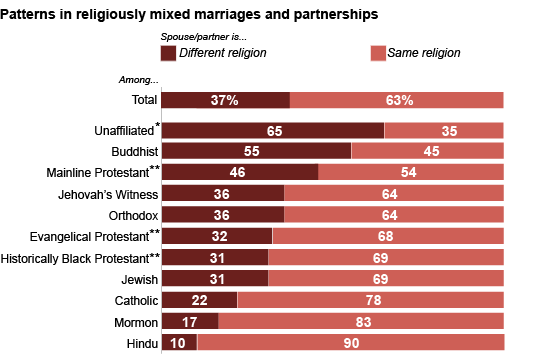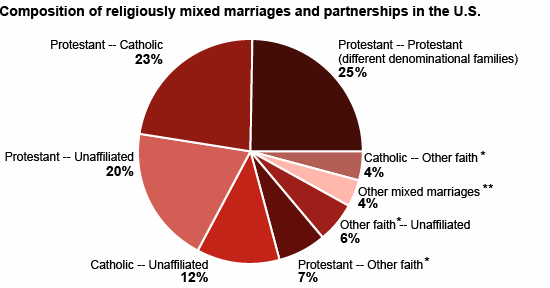Religiously Mixed Valentine’s Day
Sam Rainer
According to a recent US Religious Landscape Survey, a significant amount of people enter into religiously mixed relationships. You can read the entire findings from the Pew Research Center here. As an aside, Pew reports the findings with the following catchline: “Cupid’s Arrow Often Hits People of Different Faiths.” Intentional or not, using a Roman mythological god to introduce the subject of mixed religious relationships in America is somewhat humorous, especially around Valentine’s Day, which tradition has this day of romance named after early Christian martyrs. Mixed indeed.
Pew breaks down these findings on religiously mixed couples:
More than one-in-four (27%) American adults who are married or living with a partner are in religiously mixed relationships. If people from different Protestant denominational families are included — for example, a marriage between a Methodist and a Lutheran — nearly four-in-ten (37%) couples are religiously mixed.

In general, I question the religious commitment of unmarried couples living together, but the research did not provide a breakdown between those that were married and those that were not. Regardless, the research points to a trend – one that I did not realize was so large. Many people are in a relationship with someone of a different faith background.
First, let me differentiate between “religiously mixed” and “denominationally mixed.” Clearly, I would not recommend that a believer marry or romantically pursue anyone outside of the Christian faith. However, I have no problem with two believers getting married, regardless of denominational background. But as seen in the pie chart below, some of the more common combinations are those that cross denominational lines.

In my personal ministry experience, I’ve known numerous families that have dealt well with being “denominationally mixed.” As a pastor I’ve known families to go to Catholic mass on Saturday and then to worship at a Baptist church on Sunday morning, every weekend. It worked for them. In my research, however, I’ve found that these mixed signals can weigh on children, particularly if mom goes to one church and dad another. Children from these mixed families have much higher dropout rates.
What are your thoughts? How should the church work with families of different denominational backgrounds? How do we engage the culture that is becoming religiously mixed?







Let me just say honestly what is on my heart. Can’t we stop acclimating ourselves to the world for fear of offending their sensibilities, and instead become absorbed in serious obedience to God (in fear of offending/wounding Him)? Here is where I seek to stand: Obedience when I don’t understand why. Obedience when my cultural values scream in protest.
I am part of a “family-friendly” church today, and come from a similar background among the Plymouth Brethren. We won’t even separate the children and the parents for worship–the whole family stays together the whole time. No–may I say NO with a SHOUT–I don’t think husband and wife going to separate gatherings glorifies God or serves Him well.
Children of every age, and mom, and dad together. The family is the most basic unit. Our teaching time lasts about an hour; another hour is filled with music, open discussions, prayer, and the Lord’s supper. Afterwards, we have a potluck lunch together. “Church” runs about 3 1/2 hours.
Is this attractive to the world? Not always. But some come and are blown away at how well behaved the children are, at how much we care for each other on Sunday and all through the week. How we share what we have with each other–including our time.
Perhaps it is time to stop playing to the weakest, easiest sort of Christianity, and take up our cross everyday, and live transformed lives that feel clean and are filled with the joy and peace of obedience. We find mercy when we fail in His grace. But we aren’t OK with our failures, though we accept our penchant for sin. This fight for holiness is a serious engagement.
Can’t we risk standing apart from societies’ values, and go for God with everything in our might, with all of our hearts? From this sort of abandonment to Him, we are more prepared to love those around us, to do kindnesses, to show even our enemies the same grace we have received and enjoy.
I’m tired of what someone once called, “the bland leading the bland.” NO, I don’t care what the world does. I care what God says to do. I don’t care about human logic telling me why it is OK to toy with sinful, prideful, obstinate behaviors.
Art – thanks for stopping by. Let me clarify by saying that I do not think families that go to different churches is an ideal situation. As a pastor, when I work with denominationally mixed families, I encourage them to find one church where they can best serve. When I work with religiously mixed couples and families, the gospel has the highest priority.
My point was that there are many couples and families with mixed backgrounds – it’s the context in which we minister. The church should do whatever it takes to reach and engage them where they are without compromising the timeless message of Jesus Christ.
Sam,
What a tremendously diverse set of data. I hear of many folks who are in mixed denomination homes, and I know of very few who find it to be anything more than just OK, or acceptable. My personal opinionn is that it is VERY difficult. We are a single denomination home looking for the Word of God to drive our lives. We are far from perfect, but the last sentence of your previous comment is profound: “The church should do whatever it takes to reach and engage them where they are without compromising the timeless message of Jesus Christ.” John